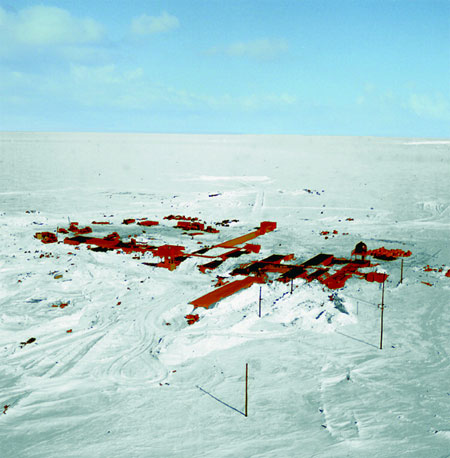Lifetime recognitionPosthumous honors for Gibbs confirm his place in history and communityPosted October 1, 2010
As a young man, George Washington Gibbs Jr. ventured to the Earth’s seventh continent: Antarctica. It is a place of unimaginable cold, stillness and quiet — at times not a sound can be heard — absolute silence. On Sept. 2, 2009, the Advisory Committee on Antarctic Names (U.S. Board on Geographic Names It was Mr. Gibbs’ second posthumous honor within a year. As a result of his civic and business leadership, the George W. Gibbs Jr. Elementary School was approved in 2008 by the school board of Rochester, Minn.; the school’s formal dedication took place on Oct. 11, 2009. In 2002, Rochester’s West Soldiers Field Drive was renamed in Gibbs’ honor. Gibbs was born on Nov. 7, 1916, in Jacksonville, Fla., and raised in that port city, afterward spending many years of his life connected to the sea. Enlisting in the U.S. Navy in Macon, Ga., in 1935, four years later Gibbs was chosen from of hundreds of applicants to join an expedition with the U. S. Antarctic Service (USAS). In 1939, Congress established USAS, and an expedition under veteran polar explorer Adm. Richard E. Byrd went south, “to consolidate previous American exploration and to examine more closely the land in the Pacific sector.” Serving as a Mess Attendant 1st Class aboard the lead expedition ship, USS. Bear, Gibbs earned official praise from Lt. Cmdr. Richard H. Cruzen, before the vessel ever departed American shores: “Especially commended by the Commanding Officer at meritorious mast for his zeal, initiative, and untiring industry, entailing much personal sacrifice, during the period the U.S.S. BEAR was outfitting and preparing for duty with the U.S. Antarctic Service.” On the morning of Jan. 14, 1940, the Bear steamed into the Bay of Whales, an indentation in the massive Ross Ice Shelf The expedition then began carrying out a wide range of scientific studies, with Gibbs helping to establish West Base (Little America III), near the Bay of Whales, and East Base on Stonington Island, Marguerite Bay, Antarctic Peninsula. He also made two round trips between the United States and Antarctica on the Bear. However, due to rising international tensions, both bases were evacuated by March 1941. At this time, Gibbs was rated an Officer’s Cook 3rd Class, again receiving recognition from the Bear’s commanding officer, in May 1941: “Commended at meritorious mast for his outstanding zeal and energy, and for the unusual spirit of loyalty and cooperation which he has invariably displayed under trying conditions encountered during the assignment of this vessel to duty with the U.S. Antarctic Service.” Gibbs would never return to Antarctica. America’s entry into World War II was just around the corner, and Gibbs saw much combat in the South Pacific during the conflict. This included service on the cruiser USS Atlanta, when she was wrecked by gunfire from the Japanese battleship Hiei and a torpedo from the destroyer Akatsuki, forcing the Atlanta to be scuttled off Guadalcanal on Nov. 13, 1942. Gibbs was afterwards assigned to a motor torpedo boat squadron, participating in attacks on Tulagi, Bouganville and New Georgia. In between this fighting, he saw combat with the First Marine Division on Guadalcanal. The Atlanta and First Marine Division both received Presidential Unit Citations for their fine performances against the enemy, and Gibbs had the unusual honor of receiving this distinction for service on a naval vessel and for land service with the Marines. 
Photo Credit: Jim Waldron/Antarctic Photo Library
Little America V in 1957 during Operation Deep Freeze.
Rising to become Chief Petty Officer Gibbs, in the late 1950s he attempted to return to Antarctica as part of the Navy’s Operation Deep Freeze. However, with peacetime downsizing, Gibbs retired from the service in 1959 with a flawless record, having earned the Navy Good Conduct Medal, silver U.S. Antarctic Service Expedition Medal 1939-41, plus several campaign medals. Moving to Minneapolis, he graduated from the University of Minnesota with a Bachelor of Science in Education. Gibbs then moved to Rochester, Minn., in 1963 to work with IBM in the personnel department. While at IBM, he received various promotions, including housing administrator and international assignment representative, before retiring in 1982. Over many years, the Rochester community benefited from Gibbs’ civil rights activism (including co-founding the local branch of the NAACP), as well as his civic and business leadership. After his retirement from IBM, Gibbs started Technical Career Placement, Inc., and continued to operate the employment service until 1999. “He lived a long life of community service and never really retired,” said his daughter Leilani Henry, who is currently researching her father’s life for a memoir. “My father enjoyed life to the fullest and said that Antarctica was his best experience!” On his 84th birthday, George W. Gibbs Jr. passed away of cancer on Nov. 7, 2000. Glenn "Marty" Stein has researched maritime and polar history since 1975, and publishes in both scholarly journals and popular publications. He served as Web site Polar Historian for the International Polar Year 2007-2008. He was a recipient of the 2008-2009 OMRS Journal Prize for research. He was the designer and recipient of the 2009 Antarctic Treaty Summit Medal (Washington, DC). The original version of this article appeared on the www.ipy.org |



For USAP Participants |
For The Public |
For Researchers and EducatorsContact UsU.S. National Science FoundationOffice of Polar Programs Geosciences Directorate 2415 Eisenhower Avenue, Suite W7100 Alexandria, VA 22314 Sign up for the NSF Office of Polar Programs newsletter and events. Feedback Form |




